The following Articles and Images have been added to the database
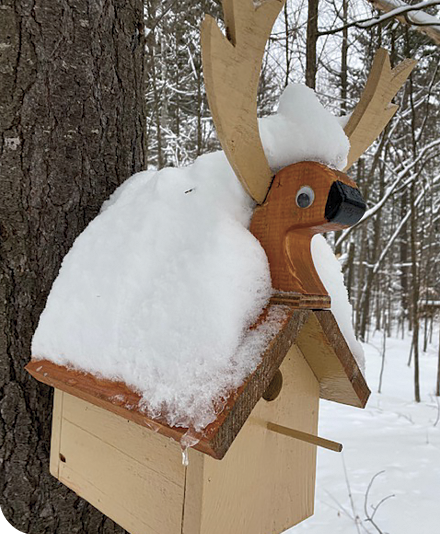
When the seed packets hit the grocery store, it’s time to think spring. While you’re planning your gorgeous garden, think of the myriad projects you could incorporate: birdhouses, bird baths, feeders and more. Backyard Beauties 2023, the online auction in support of the Mississippi Madawaska Land Trust, is three months away, giving you plenty of time to create something unique to add to the auction.
The internet provides no end of ideas, from materials to designs both funky and fashionable. Birds will flock to houses made with conventional materials, but here’s your chance to “go wild”. Not only will they want nesting spaces, but also water supplies. What about a birdbath made from a garbage can lid? What about a HUGE one made from an old satellite dish? Feeders can be as simple as plastic pop bottles, but how about creating something from a rubber boot, or a stack of tea cups, or an old tray?
Garden art with an avian theme will enhance any outdoor space. Stained glass window art, banners, plaques and fence decoration of every sort will be welcome additions to the auction.
When you’re creating your masterpiece, please remember that these items will be exposed to the elements. Use exterior products — glue, paints, grout — that will not deteriorate with the first rainfall. Hot glue and papier mâché will not suffice for this project!
Local stores can provide the supplies you will need. Check out the library for information on construction, the hardware stores for kits, J.B. Arts for paints. Visit various birding sites to get unique ideas. Gather a group of friends and work on a few houses at one time. Make this the year you see your work displayed online for all the world to see!
Check the Land Trust website <mmlt.ca> in early March to register your entry into Backyard Beauties 2023. This is the first event of the Land Trust 20th Anniversary year. Let’s make it a winner!
On a Sunday afternoon when the weather is messy, wouldn’t it be nice to meet with friends, watch a good movie together, and enjoy a social hour? Maybe see some film you wouldn’t find on Netflix? Maybe open your imagination to new ideas? A small group who used to attend films is interested in forming The Almonte Film Society. It’s not high-brow by any means, just a like-minded group who’d come together monthly to see good films on a big screen close to home. It would work similarly to the concert series: an early-bird subscription to a pre-selected programme, or single tickets to individual showings. The idea is in its early stages, but if you are interested in attending something along these lines, please contact Marny McCook at <rfmccook@gmail.com>. And no, you won’t be expected to volunteer or sign up, just show an interest.
Every two years since 2009, the MERA Schoolhouse has put out a special call to all artists and craftspeople living in this area. This call is to apply for the very generous award of $1000 given to acknowledge a body of work demonstrating exceptional artistic skill, originality and quality.
The application is open to artists working in fine arts and fine crafts. It is specifically open to local residents, those living in the Townships of Lanark Highlands, Tay Valley, Drummond/North Elmsley, Central Frontenac, North Frontenac, and the Town of Perth. Previous non-winners may apply again.
The prize is funded in large part by the generous donation to the Perth and District Community Foundation (PDCF) made by Chris and David Dodge who conceived the award. The award is administered and given by MERA.
Applications for the 2023 MERA Award of Excellence will be accepted up until April 30.
For further information, please visit MERA’s website at <meraschoolhouse.org>, email <meraschoolhouse@gmail.com> or write to MERA at: MERA Award of Excellence, McDonalds Corners/Elphin Recreation & Arts, 974 Concession 9A Dalhousie, McDonalds Corners, ON, K0G 1M0.
MERA (McDonalds Corners/Elphin Recreation & Arts) is a not-for profit charitable corporation dedicated to enriching the lives of members of its community of all ages by providing and encouraging a variety of opportunities for personal expression, instruction and appreciation of the visual and performing arts. MERA’s activities are based in a heritage schoolhouse in McDonalds Corners in the Township of Lanark.

We of a certain age need pockets in all our clothing. We don’t care that they’ll leave us with lumpy hips. Lord knows they’re lumpy already, so who’s going to notice? We’re not carrying coins to riffle through our fingers like tiny wind chimes; we’re not simply looking for a place to warm old fingers. We need those pockets for the ubiquitous tissue that is essential in drippy-nose season.
In “the olden days” our mothers carried lovely lacy handkerchiefs tucked delicately up a sleeve, where they could retrieve them discretely to be used noiselessly as required. Fathers too had large handkerchiefs tucked in a back pocket. They of course had no compunction to be discreet. Who among us hasn’t sat in church and heard a loud “HONK” from a back pew, sending us into fits of none-too-pious laughter?
Handkerchiefs were the simplest of gifts. They were cotton, decorated, monogrammed, trimmed, and presented in lovely little gift boxes, men’s in little wooden crates that could be turned into dolls’ cradles. No birthday, Mother’s Day, Father’s Day, or Christmas would have been complete without someone receiving those useful handkerchiefs. They lasted for years too. They were laundered and pressed, stored in special handkerchief pouches, and used until threadbare.
In Grade School, daily we had to show that our hands were clean and that we were carrying that handkerchief, even though we never used it. We used our sleeves for runny noses; disgusting, but there it is. And then along came Kleenex, a big box of which sat on the teacher’s desk. Every student could have a balled-up Kleenex jammed up a sweater sleeve or floating on a desktop. Hence the need for the pockets.
Once the habit of carrying a tissue was established, it remained firmly entrenched. Now I can’t be without that thing, and I need somewhere to carry it. I have a lot of pockets: jeans have four, coats three, my hoodie has two, even fancy dress pants and skirts have one, and there will likely be a tissue in at least half of them. I’m bereft if I can’t find the pocket in which I’ve secreted the darn thing, and will go looking to fill one more. Lumpy? Oh yes!
“Don’t leave home without it” applies to my compulsion to assure my drippy nose won’t embarrass me. The worst is when I have to dig through my purse to find the packet of tissues hidden in the nether reaches. I have them in the car, in the equipment bag for dog classes, and in my gym bag. They’re on the bedside table, the kitchen cabinet, the buffet. And yet, often in the moment of need, they have abandoned me.
However, I know where they are lurking. As diligent as I am at checking pockets before laundry day, I always miss one lone renegade tissue that is waiting to foul the works. What a catastrophe when I open the washer, and find every single dark item swathed in white flecks of disintegrated tissue! No amount of flicking, shaking, swiping and picking is going to remove it. I swear, if put together those bits would grow to the size of a bedsheet. If by the grace of the Laundry Goddess the darn thing manages to stay in the pocket, it morphs into a sodden ball that sticks in there like a burr, staying damp and in time solidifying to surprise you the first time you reach into that pocket. No, don’t even think of trying to unravel it! It’s a life lesson that’s going to be repeated as long as I’m committed to carrying those things.
Two handkerchief stories for you:
Story One. I had a good and frugal friend in our university days who carefully washed and dried her used tissues, declaring she saved at least two dollars over the course of her term by treating this Kleenex with deep respect. I later found out that growing up in the far north, Kleenex had been considered a luxury that her family rarely had, so when she was given the honour of coming south to attend university, she felt it was her duty to treat her possessions with great care.
Story Two. My father often thought that his parental duty was to embarrass his girls whenever possible. As my sister and I would be going out on a date, with boyfriend nervously waiting, we’d hear my Dad: “Well son, when are you getting her home?” “Not sure, Sir, not late though.” “Do you have a handkerchief?” “YES!!”
And at this point we’d run for the door, and hope we got out before he called, “Have you been to the bathroom?” SLAM! We could practically hear him laughing as we raced down the driveway!
And to this day, Kleenex is always in one or more of my many pockets.
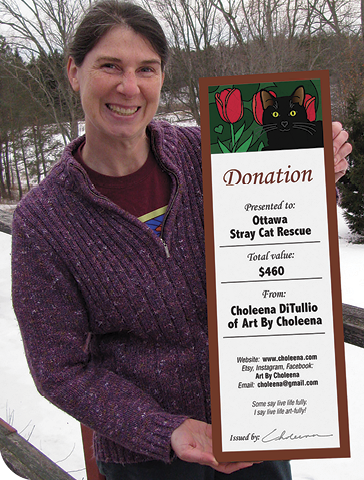

On a warm, late-October morning, Perth-area paper-mosaic artist Choleena DiTullio was getting ready to start her day in the studio. She had just finished her usual routine of walking her dog, making coffee and sitting down to check messages, when Instagram alerted her to an incoming note from Texas.
A follower of her Art By Choleena account was asking if she took commissions. They wanted a mosaic portrait of their dog. Having never sketched a dog, Choleena wrote back with hesitant enthusiasm, “I’d love to try! That subject matter is new to me so I would not ask for a down-payment until I did some sketches and felt assured that I can draw dogs.”
A few days later, with the sketching stage complete, the client and Choleena were conversing with confidence, and the final stage of creating the mosaic from the sketches was at hand. After she requested an e-transfer down-payment of $125, the client emailed a low-resolution, heavily pixelated image of a cheque. To Choleena’s surprise, the cheque was for $1000. Accompanying the cheque was a note indicating that the client’s account had a charge-back dispute, so their bank instructed them to only pay with a cheque. In addition, their bank had a minimum amount of $1000 for cheques, so Choleena would have to return the overage of $875. Suspicious of the situation, Choleena contacted the client with her concerns and let them know that it was akin to well-known Internet scams. “After some odd responses, including them scolding me for not trusting them, the client ghosted me. I guess that’s how it goes! They push until it’s clear that you’re not falling for it, and then they disappear. So, I ‘scratched’ the commission,” Choleena chuckled.
During the project (but before the ghosting), Choleena had proudly posted the image on social media, as she was excited to show her work; many liked and commented on it. Her friend Linda Berube asked if it was possible for Choleena to draw cats, and would she consider donating a piece to a holiday fundraiser of a rescue group that is dear to her: Ottawa Stray Cat Rescue (OSCatR).
Ottawa Stray Cat Rescue is a non-profit charitable organization dedicated to getting adoptable stray cats off the streets and into loving homes, as well as healthily managing feral cat colonies in the National Capital Region.
No stranger to rescues, and a companion to two rescue dogs and two stray cats, the project seemed purr-fect for Choleena, so she leaped in to help. Linda introduced her to full-time veterinarian and founder of OSCatR, Dr. Katie Jones, to work out the details of collaboration. Choleena then produced a playful mosaic that included a black cat and three red tulips. Linda helped with the title “Tiptoe Through the Tulips”, and the piece was put on auction. It received an excellent response, and soon the concept was expanded to a Variable Edition of nine more cats (an apt number for felines). A Variable Edition is a numbered set of images that are similar but with the allowance for each image to be varied in some way. In this case, clients could specify their preference for the colour of the cat and the colour of the tulips. Moments after the edition was announced, Dr. Jones pounced at claiming one. “When Choleena sent a photo of the first artwork, I instantly thought that I had to have one,” she explains. “My orange and white kitty, Sheldon, would look very handsome in mosaic, so I ordered it right away!”
All ten sold quickly, netting a total value of donations to the rescue at $460. It was clear that a second edition would be well received, and so orders are now being taken for it. The mosaics are 5”x8”, framed in black, and have a lush, glossy surface. Each is titled, signed, and numbered with an authentication label on the back, and is $160, with $30 going directly to OSCatR.
If you’re interested in immortalizing your cat with a mosaic artwork, Choleena and Ottawa Stray Cat Rescue hope that you will get in touch.
Keeping the momentum going, the existing set of images has been produced as greeting cards and postcards. Talks are also underway to research local dog rescues to partner with and support. “I hope to be able to ‘rescue’ the ‘abandoned’ dog drawing, and re-purpose it for good,” winked Choleena. Should you have a proposal, Choleena invites you to reach her by email at <choleena@gmail.com>.
Choleena tidily sums up the whole experience: “what could have been a cat-astrophe was turned around with paws-itive thinking.”
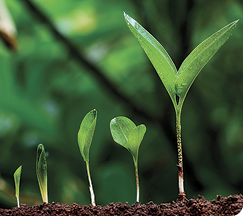
The fast moving excitement of smartphones and computer screens eclipses the slow motion of the natural world, but what the natural world lacks in speed it makes up for in depth. Over billions of years it has developed intricately cooperative associations upon which we humans have always depended. Perhaps the hard knocks of climate change will call us back to Earth before we drift off into Cyberspace.
Watch closely over a season as a seed germinates, grows to maturity and bears its seeds. It isn’t as fast as a Google search, but it will provide experience that can enrich your life and provide insight to enable following generations to enjoy their place under the sun.
Consider a single bean, covered with moist soil. The germ — the sleeping essence of the plant — wakes up and starts to grow. It takes multiple doublings in size before a first root emerges to tap into the soil.
With the plant anchored and moisture assured, the first leaves rise up — unfurling their solar collectors to absorb sunshine and feed further growth. With each new leaf, more sunshine is captured, accelerating its growth until it is big enough to support flowers and produce seeds. Seeds, like the one we started with, except there might be 40 or 60 of them on the single plant. A significant multiplication capable of sustaining our lives.
By composting the unused parts of plants, along with our bodily by-products, and feeding them back into healthy soil, the vast array of organisms residing there support their lives by metabolizing it into basic nutrients that can be used again by plants. This cycle has sustained earthly life for billions of years. It can sustain the human project for generations to come.
The wonder expands when we realize that chloroplasts, the green parts in plants that bind sunshine with carbon into sugars, is a separate life form from the plants they inhabit. This cooperative alliance was formed hundreds of millions of years ago and has come to power most life on Earth. Of similar importance are the symbiotic relationships between plants and mycorrhizal fungus which mine essential minerals from rock and deliver it to plant roots in exchange for a portion of the sugars the plant produces.
Deep cooperation goes even further! Thought to have started out hundreds of millions of years ago as bacteria, mitochondria have a remarkable ability to process the energy caught up in organic matter. They were so effective that almost all fungus, plants and animals formed close alliances, absorbing them at the cellular level. Their partners provide nutrients, and the mitochondria make energy available in return. Passed down generation to generation, since the earliest beginnings of complex life, they continue to power the show. They enable you and me to process our food, to move and to think.
Add to this the friendly viruses, bacteria and fungi that protect our skin and enable digestion, and one might wonder if we humans are independent beings or complex communities of beings that cooperate to enable our lives.
Over the eons, life forces have cooperated to enhance life’s presence. What better way to celebrate the wonders that combined to bring us to this place than to examine our relations with plants and animals and with each other, and to cultivate the cooperative relations that will enable the generations following?
Let’s slow down and smell the roses.
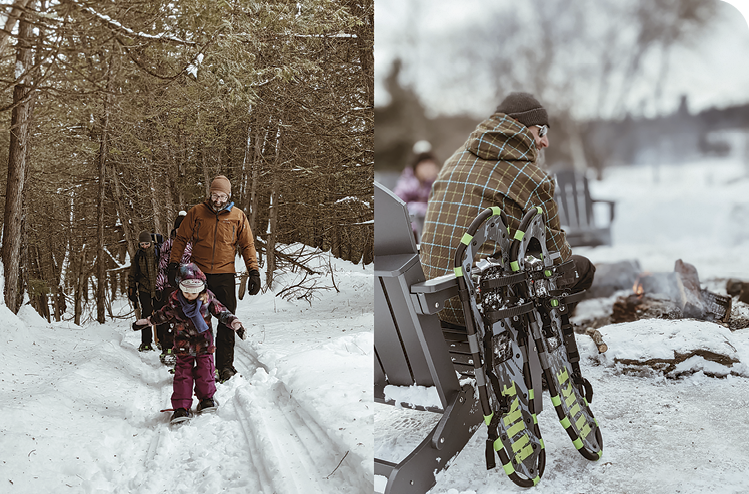
Looking to break the February Blues? Visit the cheese shop and explore the Back Forty on Saturday, February 18 between 10am and 4pm to celebrate the Family Day weekend. Enjoy the outdoors with some great food, drink and fun-filled winter activities.
With multiple toboggan runs and over five kilometres of groomed trails meandering through the farm’s forests and fields, Winterland provides a great opportunity to get some exercise, enjoy nature and reward yourself with delicious food and beverages fireside, hot from the outdoor wood oven and grill.
“Although the farm is beautiful year-round, the winter is our favourite time to explore the trails,” says owner and cheese maker Jeff Fenwick. “The Mississippi River is typically open with resident trumpeter swans, and Black Creek flows through the bush with multiple waterfalls to listen to and enjoy.”
In addition to the self-guided snowshoe trails, Back Forty has teamed up with Kick and Push Brewery to host the inaugural “River to Sky 5k” snowshoe race. If you’re looking to challenge yourself or explore a new sport, this exciting snowshoe race will provide a great opportunity to have some fun and test your fitness. After the race, participants can enjoy a Kick and Push craft beer and some delicious food fireside.
To pre-register for the race and for more Winterland details, please visit their website <artisancheese.ca>.
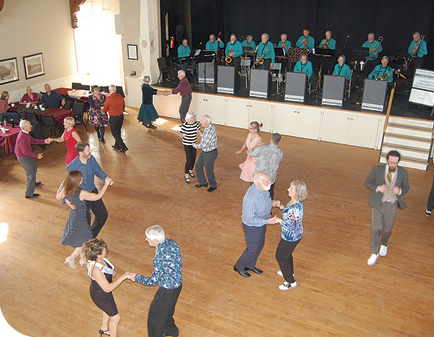
After a three-year hiatus, the Standing Room Only Big Band is excited to once again be staging Sunday afternoon tea dances in the historic Almonte Old Town Hall. There will be a tea dance on Sunday, February 12.
These afternoon dances were popular in the 1920s, ’30s, and ’40s, when big bands were king. They were generally held in hotels and, of course, featured a live band. One key part of the concept is that, as implied by “tea”, beverages served are non-alcoholic. Standing Room Only (SRO) launched the popular Almonte tea dances in ???? — seventeen years ago! They give band members a regular opportunity to perform the music they love to play in a period atmosphere, while allowing guests a chance to listen and dance to live big band music. Over the years, SRO’s Sunday afternoon Almonte tea dances have become widely known, attracting ballroom and swing dancers from as far away as Brockville and Deep River, as well as from the Ottawa area. The music naturally includes a lot of swing music, but also enough waltzes and Latin music such as cha-chas and tangos to keep the ballroom dancers happy.
The Old Town Hall is a beautiful classic old building located at 14 Bridge Street in Almonte. The dances take place on the top floor of the building, a beautifully preserved venue with a spacious wooden dance floor, natural lighting and wonderful acoustics.
SRO learned early on that its tea dances can’t compete with the nice weather, when even keen dancers would rather be outside on a Sunday afternoon, or with the holiday season. The tea dances are normally held once a month in November, January, February, and March.
The tea dance on February 12 will feature vocalist Saffron Bradbury. Saffron has sung with jazz and pop bands, and in an a capella female quartet. Her many years of experience and her versatile voice will contribute to an enjoyable Sunday afternoon.
The dance will be held from 1:30 to 4pm. Doors open at 1pm. Admission is $16 per person at the door or $30 per couple, cash only. Reservations are not required. Light refreshments will be available at reasonable prices.
For more information, visit SRO’s website at <srobigband.ca>, where you can watch video clips of the band performing for dances and concerts, or visit their Facebook page at <facebook.com/srobigband>. To receive notifications of upcoming tea dances and other public performances, send an email to <srobigband@bell.net>.
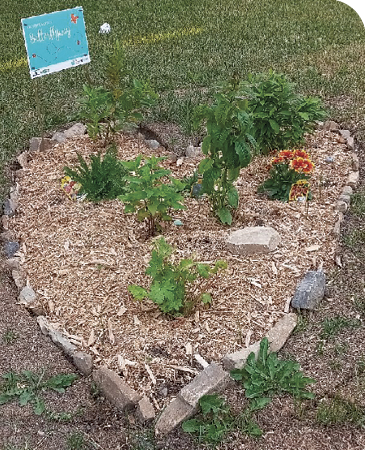
In a recent conversational with fellow Climate Network Lanark (CNL) Communications Working Group member Tom Shoebridge, I was struck by an idea of his for a CNL column in this illustrious publication.
After reading my January article here in theHumm on “thinking globally but acting locally”, his thought was that if we describe little do-able actions everyone can take to help the planet, more people might not throw up their hands at the enormity of the problem and just go about business as usual. Forming new habits related to our everyday energy and resource use is so possible. Perhaps we could parse that idea and make some suggestions that are as worthwhile as they are do-able.
Both in Canada and around the world, many people are keen to do their bit to help the planet at this critical time. Particularly younger folks have much to gain by all of us facing facts and acting on climate issues.
Here is an optimistic quote related to the youth demographic from an article by Chris Hatch, a climate reporter for the excellent and important online independent news site, Canada’s National Observer <national-observer.com>, following the recent midterm elections in the US:
“U.S. President Joe Biden gave special thanks ‘to the young people of this country who voted to continue to address the climate crisis.’ Climate-forward candidates did well at the national level.” This site provides in-depth climate reporting, as opposed to what can be found in commercially-supported mainstream media, plus there is a whole section dedicated to Climate Solutions Reporting — highly recommended!
It’s obvious that we have a responsibility to our kids and grandkids to get serious about this climate crisis we are facing. We can all get going with small daily steps in our own homes and neighbourhoods.
Below is a bit of my conversation with Tom Shoebridge.
Chandler: Tom, this approach sounds really effective. Can you describe some ways people can try to up their climate crisis action in everyday life?
Tom Shoebridge: I give a lot of thought to these matters, but just common sense shows that we, as individuals, can make a difference by being more aware of the natural world around us.
In our busy lives, we often don’t take the time to appreciate the positive natural things around us — very close to our home. Without making this into a lecture, here are a few ideas:
We can slow down our lives by periodically stopping to appreciate something simple like the trees that surround us. These beautiful creations are a wondrous work of nature. They can transform sunlight and water into food. We can delight in their shade, the music in their leaves and their testament to a healthy planet.
We can resolve to leave a tree as a long-lasting contribution to the planet. Gather people you love around you and plant a tree. Watching it grow gives personal satisfaction, retains warm memories, and captures greenhouse gases. Eventually you may need to get some binoculars and see what birds and bees are also enjoying the tree. Maybe you will make some applesauce some day or get few bottles of maple syrup!
We can expand our appreciation of green things to include planting seeds or cuttings. Start with a pot of flowers or herbs. Reduce the size of your lawn by planting a band of shrubs and flowers. Every green leaf improves the atmosphere. Every flower nurtures insects, which in turn feed the birds.
Chandler: This particular suggestion grabs me. I just read a headline today in The Globe and Mail about a study from The Harvard School of Public Health showing that the effects of losing so many pollinators because of widespread herbicide use and habitat destruction is being felt around the world. The study has found that: “Strategies to protect wild pollinators are not just an environmental issue, but a health and economic one as well”.
Your suggestion about lawns versus flower gardens is a wonderful way to create a better environment for pollinators. It seems every summer I’m seeing more and more gorgeous flower gardens! Helping the pollinators has so many rewards.
The CNL Youth Climate Action Working Group can help get folks started on a garden to attract pollinators. Check out their list of projects, including a list of resources to plant your own pollinator garden, at <climatenetworklanark.ca>.
Tom: Yes, who doesn’t love to see an Ottawa Valley flower garden. It’s one of the great optimistic ventures of our short summer! But we can also help our children or grandchildren to appreciate wider, wild spaces. When children fall in love with the great outdoors, it is proven that they carry on those habits over a lifetime. That will ensure that the next generation will take better care of the planet than this one has.
We can also travel slower. Walking and cycling puts us in touch with the earth and the atmosphere, the sky, the clouds, our surroundings. It is free and can be done all year long. Someone (most likely a Canadian) said that there is no such thing as bad weather, only bad clothing. An improvement of our health, along with that of the planet, will be the result.
We can care about the purchases we make. Stop and think: do we need something that was designed to be obsolete very quickly? Is there something local to replace an item that was manufactured or grown thousands of kilometres away? Every purchase can contribute to pollution, or not.
I hope these suggestions might be helpful.
Chandler: Thanks Tom. This is a great start, and I’d love to get more ideas about daily life in the Green Lane from readers. So dear reader — what new things are you planning to do this year to add to the inspiring job of living more thoughtfully and sustainably on our precious blue planet? Let us know! We will print a list of all the suggestions we get, and we won’t even send you a tote bag or t-shirt! Please email your suggestions to <info@climatenetworklanark.ca>.
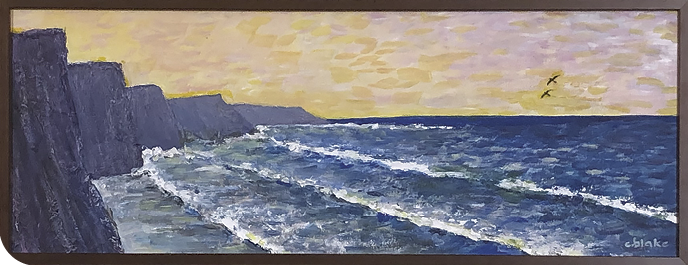
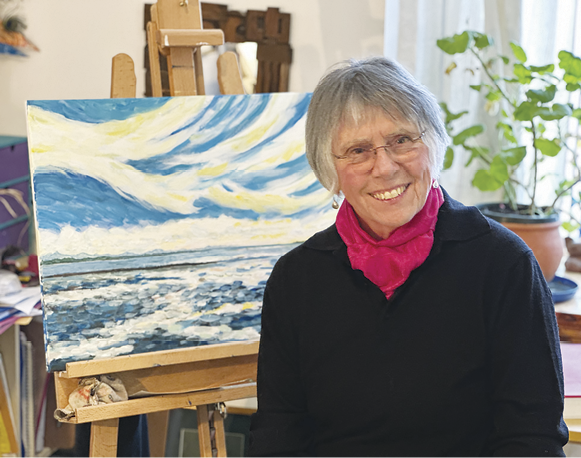
Art… and Soul
Creating art inspires her and she inspires artists — it’s a win-win for this irrepressible Almonte artist and art instructor. Nothing stops her — not polio or being a single woman working for CUSO in Zanzibar or concussion or cancer. Life hasn’t worn her down; it has both distilled and emboldened her and her lifetime passion for art. Cathy Blake’s response to my incredulity at the challenges she has faced and the opportunities she has embraced is an understatement: “I have a lot of energy; I don’t sit around a lot.”
Her art is a natural reflection of her life and her personality — exuberant and eclectic. In her words, “High school art teachers have to be generalists!” Art collectors and galleries generally prefer artists whose works are easily recognizable — a painting by Glen Loates should look like a Glen Loates painting. We all have certain expectations attached to certain famous artists, but there are as many notable exceptions, such as Picasso (painter, sculptor, printmaker, ceramicist and stage designer) and Leonardo da Vinci (whose wide-ranging interests included painting, architecture, mechanics and human anatomy). As an art teacher and now instructor, Cathy’s versatility and mastery of multiple media enable her to pursue a variety of interests and offer courses in drawing, acrylics, watercolours and mixed media.
Blake has had shows in many local venues, and her Almonte home is a showcase of some of her favourite paintings, each one with its own story. One that occupies a place of honour in her living room is a heart-warming portrait of a teenage boy with a wonderful mop of unruly hair looking disgruntled while writing an exam. He was so sure he would fail that he wrote her a note explaining why she should give him a passing grade.
Another student grew so frustrated that he stomped out of her classroom, not wanting to learn the basics of design. A few years later he called her to thank her and tell her that he was the only student in his class who knew the answer to a question in his Algonquin design course. Another kudo she values came from a former student who called to thank her for “my interesting career” as an assistant museum director. Teaching is in her blood. “Seeing them get excited about what they’re doing — it’s a real thrill to help people have that feeling.”
Cathy always loved to draw, and from the age of twelve she took lessons from an artist living near her home in Kobe, Japan, where her dad taught at Kwansei Gakuin University, a private Christian university founded in 1889. That first teacher taught her an invaluable firsthand lesson: never draw on a student’s work! “Teachers have a terrible responsibility not to hurt a kid,” she adds.
At the age of eighteen she left Japan to attend McGill University in Montréal, but by the end of her second year she wanted to quit and go to Ontario College of Art to focus on her art. She has always been grateful that her parents convinced her to complete her BA degree before continuing her arts studies, because her career as a teacher enabled her to support herself and her two daughters throughout a series of health and personal challenges. After completing her teaching certificate she spent two years in Toronto and Ottawa teaching to work off her student loans. She finally managed to go to art school in England on a part-time basis, working as a teacher one-quarter time to support herself. The Irish guy she met there came to Canada; they married, started the Bywater Pottery in Almonte, had two daughters, and eventually divorced.
For a long time her primary focus was pottery, but in 1991 when she had to support her family, she decided to return to teaching. It turned out to be a serendipitous change as it spurred her back to her first love of drawing and painting. Also, in 1995 she was diagnosed with post-polio syndrome — symptoms typically occur fifteen to 30 years after an initial attack — and the physical demands of pottery had begun to cause permanent damage to her hands and body. She thoroughly enjoyed her career as a fulltime art teacher at Arnprior District High School until her retirement in 2008.
Most of us take up reading or painting or gardening or photography or bird watching or community service or travelling when we retire. When Cathy got bored, she traveled to Asia to visit her daughter and then joined CUSO in 2010. When they offered her the possibility of a posting in Rwanda, the Gobi Desert or Zanzibar, she chose the latter with alacrity. She had always dreamed of visiting Samarkand (Uzbekistan), Timbuktu (Mali) or Zanzibar (island province of Tanzania). For a year and a half she taught secondary school teachers in a Muslim teachers’ college, until her body let her know it no longer wanted to deal with concrete floors and sidewalks everywhere. She describes it as a wonderful experience. As Pablo Picasso said, “The meaning of life is to find your gift. The purpose of life is to give it away.”
Her body may be limiting her physical options, but in no way does she allow that to interfere with her joie de vivre or her artistic endeavours. Despite a bout of cancer and a concussion from a fall a few years ago, this indefatigable spirit continues to inspire — both herself and others. After decades of experimenting with a myriad of media and subjects, she finds herself returning to her Japanese roots. “In Japan everything has a spirit, and I find myself moving back to a Shinto awareness of spirits in the trees, rocks and water around us.” And then she convinces me we are kindred spirits with her comment about a work in progress: “I’ve known that tree since I was a kid. I find myself drawing and responding to water and trees more and more because they are the guardians of our world.”
You can find Catherine Blake’s coordinates on the back of her Artist Trading Card above to learn when you might want to be inspired by taking an art course from this breath of fresh air and enthusiasm. You can also purchase her art cards at General Fine Craft at 63 Mill Street in Almonte
Artist Trading Card
.WHO Catherine Blake
WHAT Acrylics and Watercolour Artist, Art Instructor
WHERE Contact <catherine.blake7@gmail.com> and check <facebook.com/AlmonteCathy> for updates on her art and classes
WHY “Making art is for me a form of meditation — being totally absorbed in my response to my subject.”


If you’re worried about the February blahs, there’s no better place to go than The Cove Inn in Westport to beat ’em. Their line-up of musical events is sure to raise your spirits, and you can treat yourself to some terrific food and drink while you’re there!
Things kick off on February 4 with Country Pickin’ Mayhem featuring Wendell Ferguson, Steve Piticco and Shawn McCullough. These are three of Canada’s top masters of the Telecaster guitar, and this show has become an annual treat for guitar enthusiasts and music fans. In a recent interview with theHumm, Wendell Ferguson had this to say about why he loves his Telecaster: “I think it’s the sharp, twangy tone. You can do a lot on other models of guitars and sound great on them… but none of them have that twang/spank/sharpness. It’s that lead, single-coil pickup spring-mounted in a steel bridge plate (with a copper plate on the bottom). It’s a lot of metal and it’s located very close to the bridge, where it’s the twangiest.”
Wendell adds: “If you pick an acoustic guitar near the sound-hole it sounds mellow, if you pick it back by the bridge it sounds twangier… but an electric guitar strung with steel/nickel strings and a metal bridge really enhances the upper end. They’ll cut through anything! It’s like that old joke, ‘How many telecaster players does it take to change a lightbulb? None, it’s bright enough in here now!’ With a tele you’re naked, raw, exposed. It’s sink or swim.”
February 10 brings You’ve Got a Friend — a tribute to the terrific music of Carole King and James Taylor. And if you’ve got a very special friend, The Cove offers two opportunities to treat them to a Valentine’s Sweetheart Dinner and live music. On Saturday, February 11, the blues/folk/jazz stylings of Head Over Heels will accompany your feast, and on Tuesday, February 14 you’ll hear the folk/rock duo Eric Uren and Meghan Balogh.
February 17 brings the incomparable Suzie Vinnick, along with Australian blues legend Lloyd Spiegel, as part of this year’s Blues on the Rideau series. Suzie has already won ten Maple Blues Awards, one Canadian Folk Music Award and is a 3-time Juno nominee. She has also twice won the International Songwriting Competition – Blues Category, and recently released her seventh solo album entitled Fall Back Home. Her voice is a national treasure!
Lloyd Spiegel could be described as Suzie’s counterpart down under, having won a staggering 14 Australian Blues Awards while essentially growing up on stage, learning from and touring with the founding fathers of modern blues. Melbourne’s The Age says: “Spiegel is ALL presence, authority, rhythm and drive. He epitomizes control, soul and passion with white hot ferocity and blazing instrumental mastery dangerous enough to spark a destructive inferno.” Find more details about this dynamic duo, as well as other Blues on the Rideau shows, at <bluesontherideau.ca>.
Looking ahead to next month, you’ll want to book now for the March 4 Mardi Gras celebration with Spencer Evans! Find details for these and many more Cove events at <coveinn.com> or <facebook.com/thecoveinn>.

Music at MERA is excited to announce the first of their 2023 spring music concerts, featuring Mia Kelly and Basset on Sunday, February 26 at 2pm. This double bill of young, exciting talent is two shows in one.
Returning to the Schoolhouse for the third time, Mia Kelly frames her insightful lyrics with a powerful and versatile voice backed by guitar, piano, and her infectious optimism. Her fans are enthralled by her distinctive blend of folk roots and blues, and her foot-stomping, sing-along songs are anchored by her powerful voice that resonates with raw emotions.
Mia has gained a reputation as a poetic lyricist and is a born performer who radiates confidence and insight beyond her years.
The other half of the concert will feature the Toronto-based folk duo Basset, who are described by their fans as having music with timeless heart. Acoustic songwriter/singers Sam Clark and Yasmine Shelton will share their deep love of the natural world in meditative, original songs and an assured style of playing.
Basset has performed across Canada and at venues in the United States, garnering passionate fans. They will be presenting a number of songs from their latest album, In the Clay, which they released to critical acclaim in September of 2022.
The MERA café will be offering their usual array of delicious baked treats.
Tickets are $25 plus fees at Tickets Please (TicketsPlease.ca or 485–6434). The MERA Schoolhouse is located at 974 Dalhousie Concession 9A in McDonalds Corners.

From February 10 to March 24, Sivarulrasa Gallery is pleased to present Duality, a solo exhibition of new paintings by Gatineau-based artist Louis Thériault. The show can be seen in-person during regular Gallery hours: Wednesdays to Sundays from 11am to 5pm.
Born in New Brunswick, Louis Thériault began his studies in visual communication at the Nova Scotia College of Art and Design in Halifax, but reoriented his training toward applied science, earning a Bachelor of Applied Science (Industrial Engineering) in 1983 at the Université de Moncton, New Brunswick. His paintings are inspired by the places where he has lived: the Maritime Provinces in his early years, and the Outaouais region in Western Quebec where he currently resides. With a Cartesian spirit, his compositions exploit perspective, geometry and trigonometry. The works explore shapes, textures and relationships between objects, adding to or subtracting from his observations in the physical world.
The artist’s inspiration for the new body of work in Duality comes from current events, personal situations, historical facts or nostalgic moments where he has observed elements in complementarity or opposition. “As I completed the paintings, I realized that most illustrated elements opposed to or complementing each other, such as arrival and departure, shadow and light, day and night, authority and delinquency,” he states. “Other more serious subjects such as the precariousness of life and death, peace and war, are also profiled in this series of paintings.”
Louis Thériault‘s works are also informed by his Acadian origins, and the cultural richness and linguistic duality of his early family life in New Brunswick. “My ultimate motivation for creating this exhibition was to pay tribute to my late brother who could have had a career as an artist-painter but for whom life decided otherwise,” he says. “The painting Galerie praises a painter who never exhibited a single painting but who inspired me a lot personally.”
Artist Louis Thériault will be in attendance at a Reception on Saturday, February 18 from 2–4pm. Sivarulrasa Gallery is located at 34 Mill Street in Almonte. For more information, visit <sivarulrasa.com>.

Perth Tourism is pleased to present the Frost & Fire Winter Festival, taking place over Family Day weekend on Saturday, February 18 and Sunday, February 19.
This tremendous two-day, family-friendly event will provide visitors with an array of activities geared towards all ages. Experiences will be taking place throughout Perth, both indoors and outdoors.
Strap on some skates and enjoy one of the outdoor rinks, take part in outdoor laser tag, or try your hand at axe throwing. Encounter entertainers, partake in a horse and carriage ride, see artwork frozen in ice, and enjoy special promotions offered by Perth businesses. Browse treats and handmade wares by skilled artisans at the Vendor Marketplace in the Crystal Palace. Wander throughout Perth and take part in the scavenger hunt for a chance to win some fun prizes, then drop by the indoor and outdoor warming stations. Finish your day with a hot beverage and dine in at one of Perth’s great restaurants.
Experience a fun-filled weekend in Perth! Visit <perth.ca/frostandfire> for more information and to stay up-to-date on details.
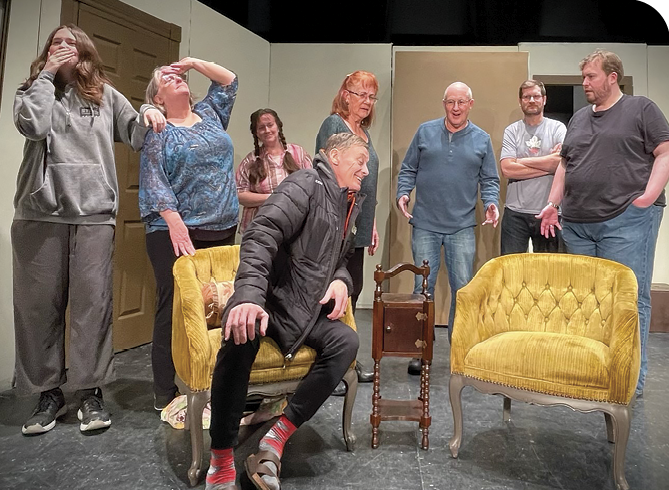
A hilarious, fast-paced comedy is coming to the Station Theatre at the end of February. With a stellar cast bringing to life a case of mistaken identity, Harvey by Mary Chase will be performed from February 24 to March 5. This newest adaptation of the well-known play-turned-film will be the directorial début of Maria Fournier and Lewis Koluk, both long-standing members of the community theatre.
Audiences will delight in the hijinks of Elwood P. Dowd and the lengths his family will go to bring back a sense of normality in this mid-century romp. Brought to life once again by Jamie Schoular, Elwood is a kind and gentle soul who cannot understand why people are so surprised by his best friend — a well-dressed rabbit named Harvey. New to the Station Theatre, Anita Plunkett brings her talent to the role of Elwood’s sister, Veta — a woman working hard to protect her family’s wealth and reputation from her brother’s antics. With the help of her daughter Myrtle May (played by Ava Legault), they hatch a plan to put Elwood in an asylum run by the famous Doctor Chumley (David Snider) and his new junior psychologist Doctor Sanderson (Jesse Gibson). From there, things start to go horribly wrong for all parties involved. Filling out this cast are the maid (Leigh Gibson), nurse Kelly (Katharine Coleman), asylum worker Wilson (Richard Croteau), Mrs. Chumley (Christine Winter), Judge Gaffney (Nathan Matthews) and Cabbie (Lewis Koluk). This amazing cast of characters will keep you laughing, questioning reality and at the edge of your seat until the final curtain falls.
The comedy opens on February 24 and runs Friday and Saturday at 7:30pm, and Sunday at 2pm. The second week sees shows Thursday to Saturday evening and ends on March 5th with a Sunday matinée. Tickets are now on sale at Special Greetings, located at 8 Russell Street East in Smiths Falls, and online or by phone (283–0300) with credit card. If tickets are still available, they can be purchased a half-hour before showtime at the door. The 6-pack of 2023 Season Vouchers is also available and will be for sale at the theatre during the run of this show. For more information, please visit <smithsfallstheatre.com>.
February boasts a lot of action at The Station Theatre! Check their website for information about all that’s coming up, including On the Road Again (a Kenny Rogers and Dolly Parton tribute concert), some magic with Sin City Illusions, a murder mystery with Great Gatsby! It’s Murder, as well as their usual movie weekend and Film Night International. A little something for everyone!
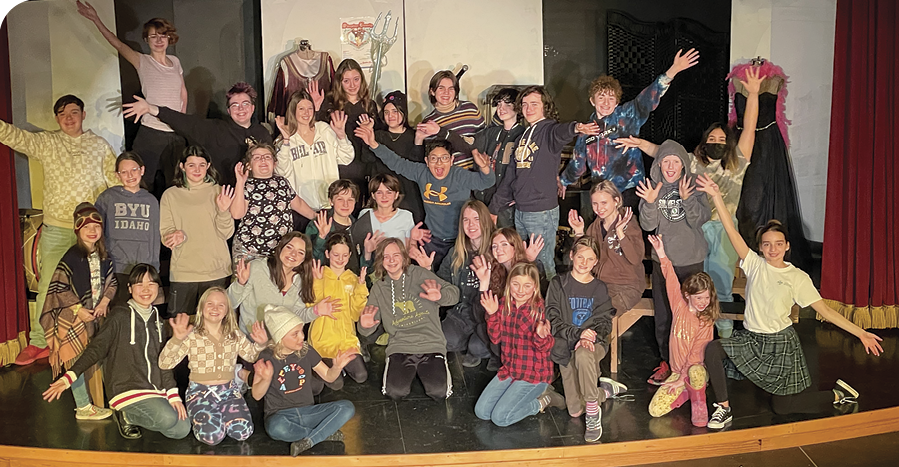
After a long hiatus of over two years, the Mississippi Mudds Youth Theatre Group is thrilled to be back on stage directing and producing a musical revue show called Raise Your Voice! The cast and team have been hard at work since September, and invite everyone to help celebrate the Mississippi Mudds’ 50th year by supporting another amazing youth performance.
In this original musical, the storyline centres around a group of students who attend a strict and regimented boarding school. Under the watchful eye of their stern principal Mrs. Prickleworth and her meek sidekick, Mr. Worminthorpe, the students are bored and restless. One day they happen to stumble upon a locked and abandoned theatre, and to their surprise they discover that the stage is far more than it appears. Behind the locked door, they find and befriend many stage characters who have been trapped in the theatre for years. Using courage, wit and friendship, the students learn what it takes to not just free their new friends, but also to follow their hearts to explore their own individuality and dreams.
Featuring a wonderful cast of 33 young performers between the ages of 9 and 17 years, the 2022/23 youth production is filled with popular Broadway songs along with a fun script that was written by the Mudds’ own Nancy Keech (who is directing the show). The production team of volunteers also include Sherrie Seward (co-director), the talented Laurel Tye (musical director), three savvy producers Abigail Brown, Linda Beiglee and Laura Bennett-Ferland, and the very organized Rhonda Bell (stage director).
As most are aware, the impact of the pandemic was significant to the performing arts community, and the Mississippi Mudds was no exception. Given this situation, the Raise Your Voice! production team really needed to be creative and resourceful to help their young cast return to the stage. This has been a pure labour of love — for the kids and for the Mudds’ commitment to making theatre available to youth in the community. With the help of some amazing sponsors, added support has allowed them to do just that, and it also provided an opportunity (and a lot of joy) in allowing them to re-purpose some amazing costumes, props and sets from many beloved past Mudds shows.
A Mudds youth show just wouldn’t be the same without many remarkable behind-the-scenes volunteers who transform the cast and help the stage come alive. Namely, Mark Tye (sound mastermind), Ann Price and Judith Scott (very talented costume designers), and Cathy Boyton (props and set guru). These folks, along with many other volunteers for hair, make-up, lights, front of house and so much more, are all integral parts of the team and it has been so refreshing and fun to be back together again.
Featuring songs from Roald Dahl’s James and the Giant Peach Jr., Children of Eden Jr., Fiddler on the Roof Jr., Legally Blonde Jr., Disney’s The Little Mermaid Jr., and many, many more, the Mississippi Mudds Youth Theatre Group invites you all to come and see the brilliant young cast perform this fun and lively musical. There are only three shows (February 24, 25 and 26), so get your tickets to see Raise Your Voice! today at Tickets Please (TicketPlease.ca or 485–6434).
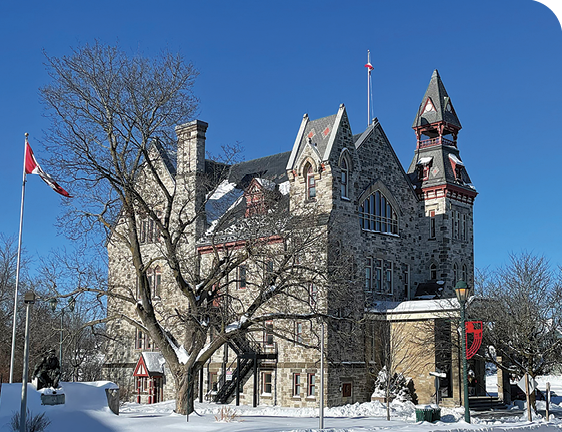
SPARC (Supporting Performing Arts in Rural and Remote Communities) is a provincial network that connects rural and remote performing artists, creators, producers, presenters and community animators. Who are community animators? You know, those folks in town who make things happen!
SPARC is launching a brand new in-person event at the Almonte Old Town Hall on Saturday, February 25.
So, what is a Regional Gathering and Cabaret? The Gathering is a peer-to-peer networking and learning day. It will feature facilitated networking and sharing in the morning. Then a catered lunch will be followed by two workshops to choose from, and a panel on engaging municipalities in the arts. In the evening it’s time for regional artists to shine! This is the Cabaret portion of the event, and it is open to the entire community. While attendees of the Gathering can attend the Cabaret for free, tickets will be available to the community at pay what you wish price points of $5, $10, $20 and $50.
Information on workshops and panelists for the Gathering will be released via our website <sparcperformigarts.com> and social media (follow us on Facebook @sparcperforming and Instagram @sparcperformingarts). Registration for the Gathering is completed via a simple google doc at <https://forms.gle/CGCar3fAQugnKYXbA>.
Oh, and did we mention that attending the Gathering is FREE? That’s right — it is totally free to attend the Gathering. And if you register for and attend the Gathering, your ticket to the Cabaret is included!
As artists are confirmed for the Cabaret, we will be sharing their info via our socials and through Tickets Please. All sales for the Cabaret will be via Tickets Please (TicketsPlease.ca, 485–6434). Produced by local talent-finder Joey Graff, the Cabaret is sure to delight. We don’t want to give too much away just yet, but here’s a teaser for you… the amazing and talented Wake Lloire will be our MC and host for the evening. Wake will be taking us on a journey filled with regional artists like Heather and Kathryn Adeney, James King and Nathan Sloniowski. Stay tuned to our socials for intro videos and artist announcements!
So if you’re within the Almonte region (which includes Perth, Smiths Falls, Kemptville, Brockville and everywhere in-between) and want to connect with your fellow members of the performing arts community, please join us for this inaugural event. We can’t wait to meet you!

I love interviewing authors. They are clever, charming, imaginative people. Hearing what they have to say about their work and the world is often a treat. This interview with award-winning writers Susan Gillis and John Steffler was done by email, but it was still a great pleasure. Their deeply insightful and captivating responses were truly a joy to read. And the wonderful thing is, because they’re on the page, I — and now you — can enjoy and savour them, again and again.
theHumm: Home is such a vital space when it comes to creative work, I find. John called your home, just outside of Perth, a “book-house.” So, you’re surrounded by nature and books, one would surmise. How does your home, and the nature you occupy, influence your creative work?
Susan Gillis: I like this phrase, “book-house,” and how it reaches out to say “house filled with books”, “house where books are welcome”, and even “house made of books”. It’s true there are a lot of books in our house...
Your question shines light on the difference between indoors and outdoors, and the all-important passages between the domestic and the wild. The passages: house to porch, lawn to screen house, gardens, fields, woods, wetlands, forest, lake and beyond. Or list back, from the wild to the domesticated.
Threshold spaces like this are utterly compelling to me, and a lot of my work is situated in or written from them: the screen house where Yellow Crane took shape, the window overlooking a neighbourhood under construction at the heart of that book; the St Lawrence River seen from a balcony in Montreal’s Habitat 67 in The Rapids; the shady terrace that let me time-travel in Volta — spaces where the imagination can roam freely — yet not too far from books!
John Steffler: Every writer’s needs are likely to be a bit different. Some like to be surrounded by human activity, loud music, urban commotion. Some go off to work in a separate studio. Since I work at home, home needs to be – among other things — a place that allows me to write. I seem to need a calm, private place a bit removed from the busy human world. For me, being close to the natural world is important in ways that go beyond what’s needed in a convenient working environment.Some writers would hate to live where we do, but fortunately Susan and I seem to have roughly the same needs and habits as writers.
That leads me to this question: What are you working on at the moment? What are you reading? Has any book recently devoured your attention?
Susan: I’m reading, as usual, a bunch of books at once, moving through the day in a loose pattern that’s evolved over a few decades.
Mornings are for engaging with poetry, writers and artists on their work or lives, research on colour and light, appetite, the living world, ideas... Some of this finds its way into my notebook in notes that in turn may (or may not!) open to poems; “Burnt Umber” and “Beauty Spot on the Wing of a Mallard Drake” both began with the fascinating little volume Werner’s Nomenclature of Colours, the source Darwin used for colour descriptions during his HMS Beagle voyage.
Evenings are for fiction. I recently read Sheila Heti’s infuriatingly brilliant Pure Colour. Have a few lines of prose ever inspired a compulsion in me the way Heti’s innocuous yet mesmerizing half-paragraph about “the jewel game” did? This game I only vaguely knew about, Google-searched, and now can’t stop playing? The book is full of this kind of thing, strange and unsettling, and deeply human.
John: I’m writing poetry.I’ve been reading Malcolm Andrews’s wonderful study Landscape and Western Art; David Graeber’s and David Wengrow’s book The Dawn of Everything — a rethinking of human history, western culture and the process of colonization since the so-called age of discovery; In the Same Light: 200 Tang Poems for Our Century — fabulous translations by Wong May; Tomas Tranströmer: Selected Poems, edited by Robert Hass; About Looking by John Berger; Sheila Heti’s Motherhood; Maureen Scott Harris’s More than One Homage; and Guy Debord’s Society of the Spectacle. Also books on Cézanne and Bosch, but that’s enough.
Some folks might think two writers living together might be a wonderful thing, an inspiring circumstance at every turn, perhaps. Others might cringe and say, oh no, that might be disastrous. How does that work in your home? Is it a good thing to live with someone who loves writing as much as you do?
Susan: It’s great to know my writing practice is something my life partner understands. We’re quite compatible in our “ideal conditions” for practice — quiet, solitude, space, time — which I know for some artist-couples isn’t the case, which can be challenging. And it’s great to share this love of words; our jokes are pretty much all word jokes. It’s also handy on occasions of ceremony and ritual, or when one or the other might be at a loss for words, or when exuberance makes us giddy.
John: I think it works well for us. It works well for me. We’ve been together a long time, and we’ve been writers all our lives; so, I can’t imagine being together any other way. We both like quiet and freedom. We talk about writing and reading a lot, but we don’t collaborate on projects, and we generally don’t talk much about what we’re working on individually at the time. Since we’re both writers, we can respect and sympathize with each other’s habits and needs.
Both of your most recent collections of poetry, it seems to me, had something in common — that is, there was an awareness and an uneasiness of sorts in the poems about the natural world and what we’re doing to it. Perhaps you could speak to your concerns about the environment, your admiration and love for the natural world, and how those things make their way into your creative work.
Susan: That’s a good observation, about these concerns driving the work of both of us, though we take different approaches to those subjects. My most recent book Yellow Crane has been described as a love-poem to a city, yet it’s concerned with what we destroy as much as what we build. It’s also a love-poem to hayfields and gardens and the movement of ideas through culture, and these have inescapable, usually devastating, impacts on the natural, wild world.
Though there are lots of artists and writers producing wonderful environmentally conscious work, there’s also a great deal of cultural content, especially in the more commercial sectors, that seems to come out of trying to escape or deny, or to simply ignore, the devastating changes in the natural world we occupy. I can’t really do that, nor do I want to, even in poems that aren’t directly about the natural world. At the same time, gratitude and praise and hope, which I think about a lot (and maybe this speaks to your word “admiration”), are my foundation, and so is the amazing grace that humans are capable of enacting and experiencing, somehow side by side with our hubris.
John: I grew up in a rural area that was being obliterated by the expanding city of Toronto, and in my twenties I moved to the rugged, sparsely populated west coast of Newfoundland where I wrote my first seven books including The Grey Islands and The Afterlife of George Cartwright; so, the relationship between rural and urban, nature and culture, wilderness and industrial technology has long been at the centre of my writing and personal life. And now, as with so many of us, the looming environmental/ecological crisis facing humanity overshadows all my thinking. I can’t help feeling that the human species has been deluded about itself for a long time. Our efforts to create a material paradise on Earth are backfiring. This kind of thinking is hard for all of us, and it’s what I grapple with in Forty-One Pages: On Poetry, Language and Wilderness. In these circumstances, a writer is apt to doubt the value of writing, the value of an audience, the value of language itself. And yet, being a writer, I go on writing about these things themselves.
Finally, what is that drew you to make your home in Perth? And is it a good place to make art?
Susan: Perth drew us to Perth! We both loved the limestone buildings, the graceful park, the active river, the heart of town, the friendliness, proximity to other towns and cities, the absence of strip mall development (though sadly that’s changing)... and the surrounding terrain. It seemed like a place people actually lived and worked in, the kind of place built on a human scale, for people. It felt like a place we could make a home, bringing our separate lives lived in two places (for more than a decade!) together into one. And we have!
John: Like many writers, while I want to be alone a lot of the time, I don’t want to be completely alone! It’s important to feel at least loosely part of a community of other writers and artist, to be near a town or city with some cultural amenities, and Perth offers this. So far, it also still has an intact historical character of its own; it hasn’t become a generic suburb of a larger centre. And I was drawn to the Canadian Shield landscape that begins a bit west and north of Perth. Here in Lanark County, we’re far enough out on the fringe of the industrial/urban world to feel — in spite of the dire global news — that it might still be possible to live close to nature without completely destroying it. Home here is both a commitment and a kind of retreat.
For more on Susan’s and John’s books and latest work, you can visit susangillis.ca and stefflerjohn.blogspot.com.
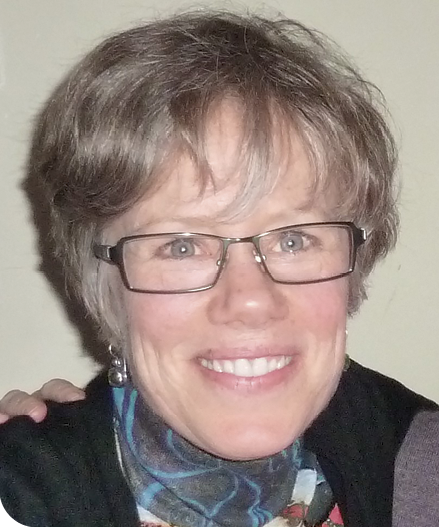

I thought I was pretty up-to-date on gender and sexuality, but then I listened to my friend’s six-year-old grandson gently explain the school’s gender-neutral bathrooms to his four-year-old brother. He made me realize that if I want to have meaningful conversations with my grandkids about what they’re learning at school, I’ll need to up my game! I include my pronouns (she/her) when I sign my name and have been asked why, sometimes with genuine curiosity, sometimes with hostility, and I wish I had more articulate answers. Somehow, “To demonstrate support” just doesn’t cut it. Four of my close friends have grandkids who identify as transgender, and I wonder quietly what factors are at play to explain this apparent surge, but I don’t give voice to that for fear of being perceived as unsupportive. I know that LGBTQ+ teens are four times more likely to die by suicide, but I don’t know how to be an effective ally/advocate and I would like to be part of the solution. These are just a few of my questions, and I’m sure you have many as well.
Issues around gender and sexual diversity are making headlines every day, largely driven by the strong feelings they invoke from all corners of society. Sadly, however, the stories behind many of these often-inflammatory headlines tend to be anything but nuanced, lacking both context and evidence; consequently, they serve to intensify positions and consolidate discord. Open analysis and the effort to seek deeper understanding is thwarted by a fear of being perceived as intolerant or dogmatic. So we avoid the conversation and miss out on opportunities to learn more and to better understand one another.
Learning Again in Almonte is creating an opportunity to explore some of these myths and fears in the upcoming course Understanding Gender and Sexual Diversity. Presenters Karen Luyendyk, a nurse with significant experience in trans/non-binary health, and Chrissie Young, who designs gender and sexual diversity inclusion training for the Federal Public Service, hope to create a safe space for questions and open conversation over four Tuesday afternoons, beginning, appropriately, on February 14 at the Almonte Branch of the Mississippi Mills Public Library. A fifth session (possibly an evening) is also in the works, with a panel who will share diverse personal experiences and wisdom. For further information and to register, please go to <learningagainalmonte.ca>.
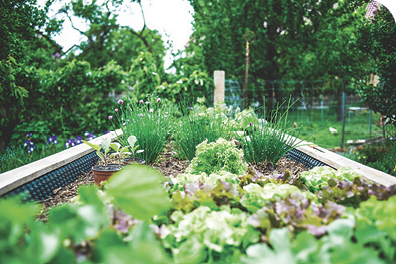
Who knew that gardening advice clinics could be asked to resolve marital disputes?
In my over 20 years as a Master Gardener, I have participated in hundreds of advice clinics and from time to time have faced an irritated couple who were at loggerheads over their garden. I have learned to tread carefully and perhaps point out that there may be more than one way to prune (or not prune) a tomato plant!
A bit of an aside, but I always find it fascinating how couples work out methods to share a garden space: perhaps she grows the flowers and he grows the veggies; perhaps he does the heavy lifting and she does the plant care; perhaps she operates the motorized equipment and he operates the secateurs; or, worse case scenario, the lot is divided down the middle with a razor-wire divider!
Admittedly, most garden advisors should not be relied on for relationship advice, and in my experience most relationship advisors are not that interested in gardening. So, where does one go for gardening advice? I admit that I’m biased, but may I recommend your local friendly Master Gardener for free, unbiased and objective gardening advice?
Lanark County Master Gardeners and Ottawa-Carleton Master Gardeners are two of about 30 Master Gardener chapters in Ontario. They are under the umbrella of Master Gardeners of Ontario Inc. (MGOI), which began in 1985 as a program of the Ontario government to help home gardeners and to take some of the load off of County Agricultural Agents.
Master Gardeners have studied horticulture extensively and continue to upgrade their skills through technical training. They are very often specialized in their area of knowledge and experience; for example, many are very knowledgeable about perennial plants‚ whereas my expertise is largely with vegetable gardening. One of the strengths of the groups is the ability to draw on the expertise of fellow members. Master Gardeners are required to provide a minimum number of volunteer hours and provide horticultural information to the public, at no charge, via garden clinics (many at Farmers’ Markets), telephone, letters, displays, workshops, television, and radio and newspaper articles.
Experienced gardeners are recruited locally, often from Horticultural Societies. In turn Master Gardeners are often asked to be speakers at monthly meetings of Horticultural Societies.
Our local Master Gardener group has allowed me to try different approaches to spreading the knowledge of gardening and of growing our own food with youth centre gardens, community gardens, the food bank garden, retirement homes and group homes. The response is variable, gardeners being a rather unruly lot, but in general the reaction is very rewarding as new gardeners experience the thrill of harvesting and eating a vegetable that they have grown.
If you are interested in obtaining more information about becoming a Master Gardener, go to <lanarkmg.blogspot.ca>, <mgottawa.ca> or <MGOI.ca>.
If you are not ready for that level of commitment, may I suggest joining a Horticultural Society. The Ontario Horticultural Association was created by the Province of Ontario in 1906 and has 270 autonomous local societies and over 30,000 members.
Where would I find a local Society? What is amazing to me is the number that are within easy driving distance. Within a fifteen-minute drive from the Almonte Old Town Hall there are four societies to be found — if one is willing to drive 45 minutes one has a choice of an additional ten societies. Learn from other local gardeners and from knowledgeable guest speakers. Society membership often brings other perks, such as discounts at local garden centres. Go to <gardenontario.org> to find the nearest society.
There are many other sources of gardening knowledge out there. I have found seed catalogues surprisingly good sources of information about varieties, horticultural techniques and pest information. Not surprisingly, companies based in Ontario provide more appropriate local information than ones based in British Columbia.
Consulting the “Wicked Wild West” has its perils. Algorithms designed to send one down a rabbit hole and spend buckets of money on the latest shiny gardening fad are to be avoided. Potatoes growing upside down in a hanging basket are just not going to do well. If it sounds too good to be true, it very likely is.
One of my main “go-to” sites is the website of the Ontario Ministry of Agriculture, Food and Rural Affairs — I find it is really good on horticultural information, but its recommendations are often more appropriate for commercial growers. Many university websites are also great sources of information. I go to sites that have information germane to our local conditions such as University of Guelph or University of Minnesota. Of course, I could always pull down one of the hundreds of gardening books that are gathering dust on my shelves.
I frequently peruse local gardening Facebook groups. Some of my favourites are Master Gardeners of Ottawa-Carleton, Almonte and Carleton Place Gardeners, and Edible Ottawa Gardens.
I do not always agree with the approach of well-meaning folks, and I sometimes find myself asking why they did not just go to an authoritative source. After some sober thought, the wisdom of going directly to our local gardening peers struck me. I have conducted dozens of gardening workshops — it is really difficult to know what to include in a one- or two-hour presentation. The reality is that no matter how hard one listens, it is nearly impossible to retain enough information to put it all together. It takes a whole lot of hands-on experience, and what better source of advice than other local gardeners who may have already grappled with the issues that are bedevilling you?
I always try to talk from my own personal experience and what has worked for me. But my way is not the only way — there is no substitute for trial and error to see what works for you and your neighbours.
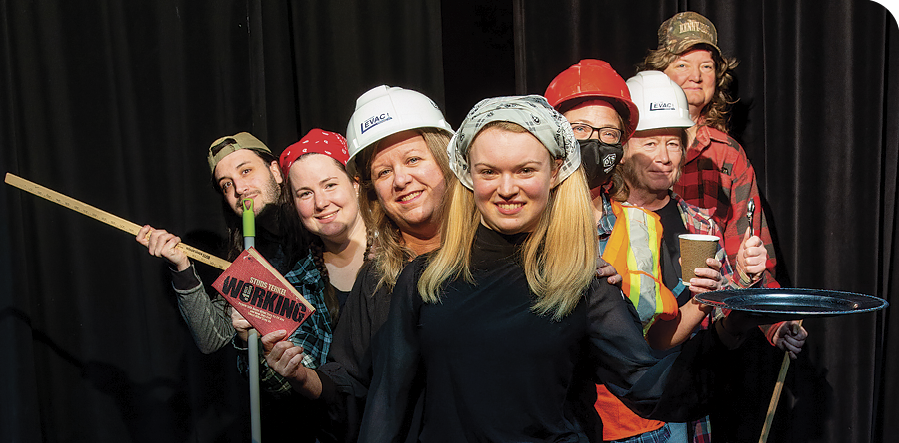
Did you ever have one of those days? Stuck in your car behind the garbage truck, grinding your teeth in frustration because you are late. At each driveway a young person, dressed in a hoodie, jeans and work boots swings down off the back of the truck. They hoist the bins and bags up into the truck and then they are back on their perch, giving the truck a thump on the side to let the driver know they’re on board. Did you ever wonder what their story was? Or how about the story of the person who waits on you in the local diner? Or the construction worker you see up on the scaffolding of a new high-rise apartment? These workers inhabit the framework of our lives, and yet we know so little about them. Where did they come from? Where are they going? Why are they doing this job? These questions are all answered in the rock musical Working, coming to the stage at Perth Studio Theatre.
Your feet will be tapping and your hands will be clapping as an iron worker, a housewife, a millworker and a firefighter, to name just a few, sing and dance as they tell their stories. The musical is based on real life interviews by Studs Terkel with everyday people doing everyday jobs.
Speaking of music — wow! You’ll hear songs by James Taylor, Lin-Manuel Miranda and other talented lyricists, plus you get to see Brent McLaren, Working’s musical director, playing his rock-band monster Hammond organ on stage, alongside a phenomenal percussionist, bass player and guitarist.
Someone may need to write a play about the roller coaster search for a keyboard player that led to the behemoth rock band organ — because if it can’t fit in the theatre elevator the Working crew will have to engineer a way to hoist it into the theatre via the sky door from the street below.
Don’t even get this writer started on the amazing cast in this production! Seven “workers” sing and dance and build the set as they portray over 20 roles. Sarah Jane Laberge, an accounts payable administrator and a real-life mom to a 12-year-old, portrays a fast-food delivery employee and a beleaguered receptionist — among others. Zach Brown, working real time in a pet supply store by day, is up on stage as Rose Hoffman, a third-grade teacher, and then as the grandchild of a stone mason. The cast also includes the multi-talented Claire Campbell and Diane Cote, both just recently on our stage in the 2022 Muses and Mysteries One Acts. Add to that the amazing vocalist Sarah Wibberley, plus our own Dave Corbishley (is there anything Dave can’t do in our theatre?). New to our stage in this production is the talented Emily Morris Cree.
Our multitalented director, Dani Corbishley, first brought this show forward for our consideration. Dani is directing and choreographing this great piece. Although the subject matter may be for more mature audiences, this production is sure to knock your socks off!
Working is the perfect antidote for the February blues. A pair of tickets are a great date idea for you and your favourite friend or partner. Our Valentine’s gift to the community — not to be missed.
The play opens on Thursday, February 9 and continues on February 10, 11, 16, 17 and 18 at 7:30pm. Matinées are Sunday, February 12 and Sunday, February 19 at 2pm. All performances will be held at Studio Theatre Perth on Gore Street. Tickets are $27 and can be purchased at <TicketsPlease.ca> or by calling 485–6434. Tickets are also available at the door. For more information, please visit <studiotheatreperth.com>.